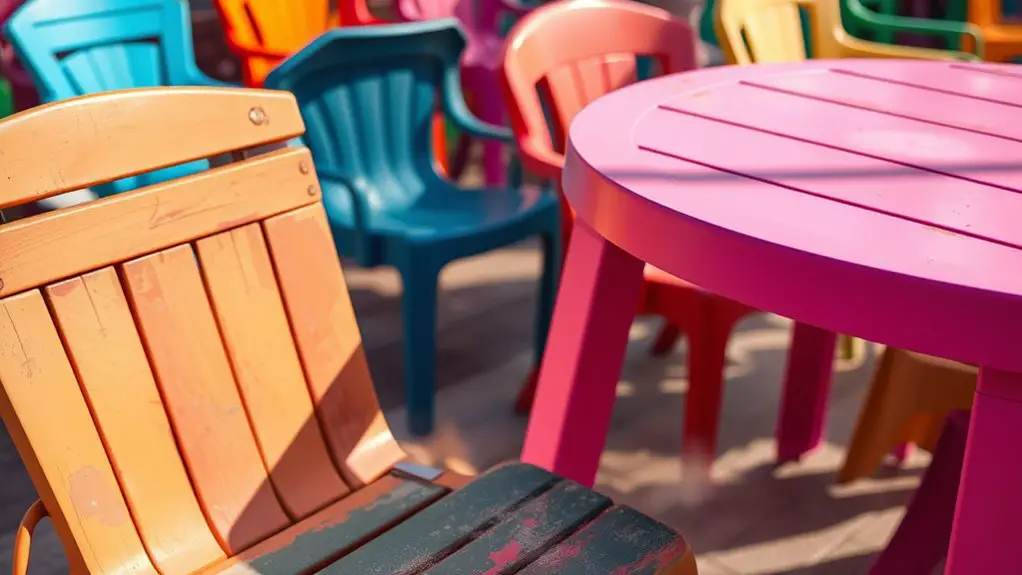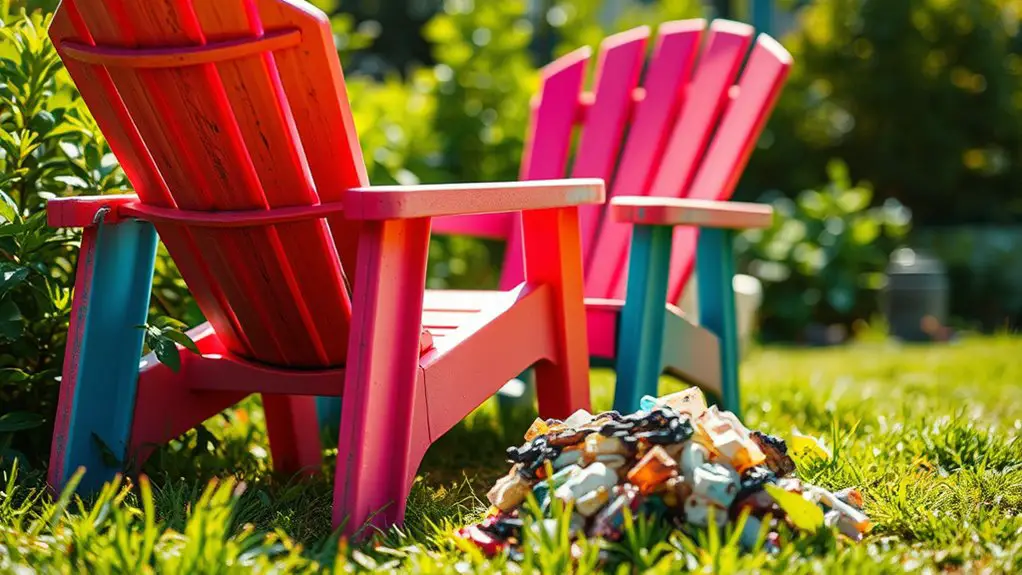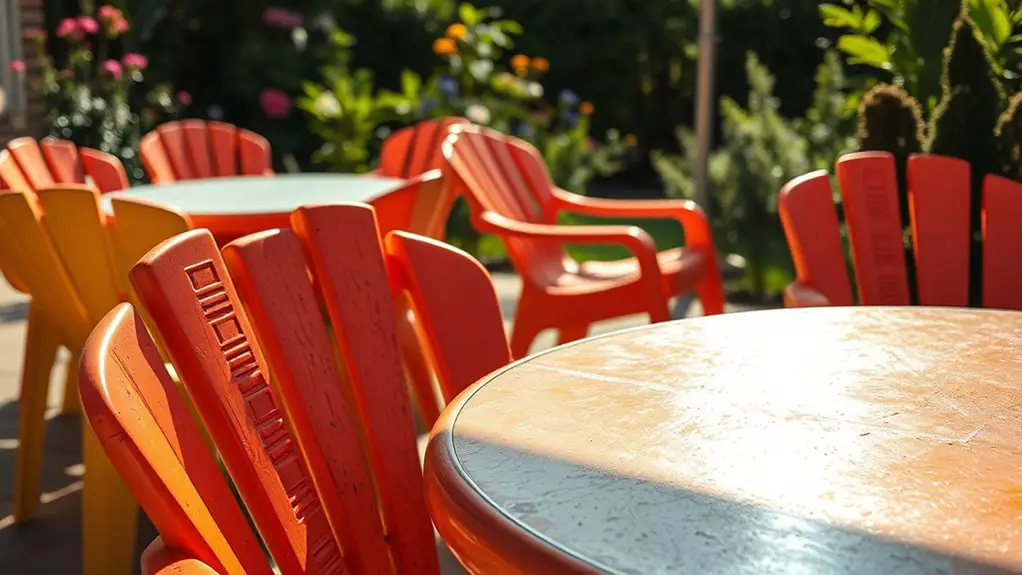When considering plastic furniture as a long-term investment, you'll find it boasts an impressive lifespan of 10 to 20 years. Its high-density polyethylene (HDPE) and polypropylene construction offers strength, durability, and resistance to dents, scratches, and UV damage. This means it can withstand various weather conditions without fading or degrading. Maintenance is minimal, requiring just a bit of regular cleaning to keep it looking good. Plus, choosing eco-friendly, recycled options can enhance your investment further while helping the environment. You'll discover more benefits and considerations by exploring what makes plastic furniture a great choice for your space.
Key Takeaways
- Plastic furniture typically has a lifespan of 10 to 20 years, influenced by material quality and environmental factors.
- High-density polyethylene (HDPE) supports heavy loads and offers durability against dents and scratches, ensuring longevity.
- Weather-resistant features, including UV and moisture resistance, maintain integrity in various environmental conditions.
- Low maintenance requirements reduce long-term costs, as regular cleaning is straightforward and less frequent compared to other materials.
- Initial lower costs and long-term durability provide a favorable cost-benefit ratio, making plastic furniture a wise investment.
Material Strength and Resilience
When it comes to plastic furniture, material strength and resilience are crucial factors that determine its longevity and performance. You'll find that most of this furniture is made from high-density polyethylene (HDPE) and polypropylene, both known for their impressive durability.
HDPE, in particular, boasts a high strength-to-density ratio, allowing it to withstand heavier loads than many other plastics. For example, resilient premium tables can hold up to 2000 lbs without compromising their structural integrity. Additionally, HDPE furniture is weather resistant, enabling it to endure a variety of environmental conditions without significant wear. This feature is particularly important when considering furniture for high-traffic areas and outdoor spaces.
Moreover, HDPE furniture is dent- and scratch-resistant, making it ideal for various environments. You can expect it to last for decades, even under harsh conditions. Maintenance is straightforward; you only need soap, water, and a soft bristle brush for cleaning. Plus, it resists many common solvents and acids, so you won't have to worry about wear from cleaning chemicals.
The manufacturing processes, such as injection and rotational molding, enhance the material's strength from the start. Using stainless steel hardware further boosts durability. HDPE furniture is also made from recycled materials, reducing the demand for raw resources and promoting sustainable practices.
With these features combined, you can feel confident that your plastic furniture is a long-term investment that will serve you well.
Weather Resistance Features
One of the standout features of plastic furniture is its impressive weather resistance, ensuring it remains functional and visually appealing in a variety of conditions. You'll appreciate how materials like polypropylene and HDPE are designed to withstand the elements, from harsh sunlight to heavy rain. Additionally, the use of recycled plastics not only contributes to sustainability but also enhances the durability of the furniture.
Here's a quick comparison of key weather resistance features:
| Feature | Benefits | Materials |
|---|---|---|
| UV Resistance | Prevents color fading and degradation | Polypropylene, Polycarbonate |
| Moisture Resistance | No absorption, preventing swelling and warping | Polypropylene, HDPE |
| Temperature Stability | Stays stable in extreme temperatures | Polypropylene |
| General Durability | Withstands rain, snow, and sun | Polypropylene, HDPE |
| Maintenance Free | No rust or staining | All weather-resistant plastics |
With these features, your plastic furniture can endure year-round exposure without losing its charm. You can confidently invest in pieces that promise longevity and minimal upkeep, making your outdoor spaces more enjoyable regardless of the weather.
Maintenance Requirements

Proper maintenance is essential for preserving the longevity and appearance of your plastic furniture. Start by regularly dusting off your pieces with a microfiber cloth. For general cleaning, use lukewarm water mixed with mild soap. Avoid abrasive substances and harsh chemicals like ethyl alcohol, acetone, and ammonia, as these can damage the surface. Additionally, it's important to note that knowledgeable staff at retail locations can provide tailored advice on maintaining your specific type of plastic furniture.
If you encounter tougher stains, you can safely use a diluted solution of white vinegar or bleach, but always rinse thoroughly with a garden hose afterward.
Make sure to clean your furniture frequently to maintain its look. For outdoor pieces, increase the cleaning frequency due to exposure to the elements. After each use, wipe down your furniture with a damp cloth to prevent grime buildup. Deep cleaning is necessary after prolonged outdoor use or during dirty weather.
Be cautious with material-specific care. For polycarbonate resin, use clear water and a microfiber cloth to avoid scratches.
Lastly, always dry your furniture with a soft towel or let it air dry in the sun to ensure it stays in great shape. Following these maintenance steps will keep your plastic furniture looking its best for years to come.
Durability Against Wear
Maintaining your plastic furniture not only enhances its appearance but also contributes to its durability against wear. Made from high-density polyethylene (HDPE) or polypropylene, this furniture is incredibly strong and resilient. Unlike wood or metal, it's resistant to cracking and splintering, making it ideal for everyday use, even in high-traffic areas.
Plastic furniture holds up well against harsh weather conditions, too. With UV-resistant materials, it withstands scorching sun, heavy rain, and extreme temperatures without degrading or losing its aesthetic appeal. You won't have to worry about color fading or material degradation over time, ensuring your furniture maintains its structural integrity. Additionally, its longevity in challenging environments means that it can thrive in various settings without compromising its quality.
Moreover, you'll appreciate its resistance to common wear and tear. Stains, scratches, and dents hardly affect its surfaces, making spills and food stains easy to handle.
With minimal wear over the years, your plastic furniture can endure heavy use without significant deterioration. This long-lasting performance means fewer replacements, saving you money in the long run. By investing in plastic furniture, you're choosing a durable option that retains functionality and appearance for many years to come.
Environmental Sustainability

Embracing plastic furniture is more than just a practical choice; it's a step towards environmental sustainability. By choosing furniture made from recycled plastics, you reduce reliance on virgin resources, helping to preserve our natural habitats. This not only minimizes resource extraction but also supports sustainable practices by reusing post-consumer waste.
Moreover, plastic furniture significantly decreases landfill waste. When you opt for these products, you're diverting plastic from landfills and oceans, which reduces pollution and protects wildlife. Each piece you choose helps manage waste more effectively, preventing landfill overflow and contributing to a cleaner environment.
Additionally, the production of recycled plastic furniture has a lower carbon footprint. It requires about 70% less energy compared to manufacturing new plastics from raw materials, cutting down on greenhouse gas emissions. This supports a circular economy, where materials are reused rather than discarded. Furthermore, choosing HDPE furniture exemplifies a commitment to sustainability by offering durability and resilience in outdoor settings.
Lastly, by promoting responsible consumption, you're protecting vital natural resources for future generations. The extension of materials' lifespans and the encouragement of recycling practices ultimately lead to less wasteful habits, ensuring a healthier planet for all.
Frequently Asked Questions
How Does Plastic Furniture Compare to Wood in Terms of Lifespan?
When comparing plastic furniture to wood, you'll find plastic lasts significantly longer. While wood often needs replacing in about ten years, high-quality plastic can endure for 20 years or more, proving to be a wiser choice.
Can Plastic Furniture Be Repaired if Damaged?
Yes, you can repair plastic furniture if it's damaged. Gather the right tools and materials, replace broken parts, and use epoxy to secure new strips. Regular maintenance helps extend its lifespan and keeps it looking good.
What Are the Color Options Available for Plastic Furniture?
You've got a wide array of color options for plastic furniture! Choose from vibrant shades like red, blue, green, orange, or classic white, and mix them to match your outdoor space's style perfectly.
Are There Any Warranties for Plastic Furniture Products?
Yes, many plastic furniture products come with warranties. For instance, By the Yard offers a 35-year warranty, while C. R. Plastic Products provides a 10-year warranty for residential use, covering defects in materials and workmanship.
How Does the Weight of Plastic Furniture Affect Stability?
The weight of plastic furniture directly affects its stability. If you exceed recommended limits, you risk breakage. Choosing well-designed pieces ensures even weight distribution, enhancing stability and durability for your needs.

